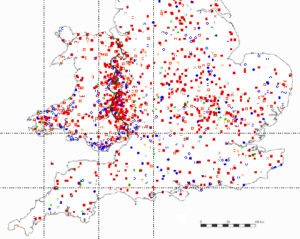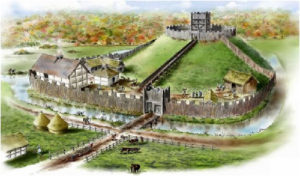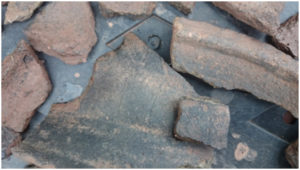In 1066 the Normans arrived and Harold, who had only been king for six months, was killed at the Battle of Hastings. William the Conqueror granted the county of Hereford to his commander William FitzOsbern. With Walter de Lacy and other tried soldiers, he had the task of defending the frontier against the Welsh.
 William FitzOsbern was determined that Hereford would not burn again. He and Walter de Lacy set about building a chain of castles from Chepstow to Ludlow to control the main routes out of Wales. They both gave land to their knights, who in return manned the main castles and sometimes built fortifications of their own. Soon there was a concentration of castles all along the border between England and Wales.
William FitzOsbern was determined that Hereford would not burn again. He and Walter de Lacy set about building a chain of castles from Chepstow to Ludlow to control the main routes out of Wales. They both gave land to their knights, who in return manned the main castles and sometimes built fortifications of their own. Soon there was a concentration of castles all along the border between England and Wales.
The Domesday Book records the lands Walter left to his son, Roger, after he died in 1085. He was one of the wealthiest men in the country with 163 manors across seven counties. At Ewyas, Roger had farmland in the castlery of Ewyas Harold, as well as three churches and one priest. He also had land in Ewyas that was not within the castelry, so it had only recently been taken from the Welsh. “From this land Roger has 15 sesters (14kg) of honey and 15 pigs.” We are not told the extent of this land bu t, from other entries in the Domesday Book where the rent was paid in honey, it appears that Roger had as much land as could be ploughed by 10 teams of oxen – about one square mile. In addition he must have had extensive pasture and meadowland to feed the oxen and other cattle, as well as forests where the pigs could forage.
t, from other entries in the Domesday Book where the rent was paid in honey, it appears that Roger had as much land as could be ploughed by 10 teams of oxen – about one square mile. In addition he must have had extensive pasture and meadowland to feed the oxen and other cattle, as well as forests where the pigs could forage.
It’s clear that within 20 years of the Norman Conquest the de Lacys were defending a very substantial land holding in Welsh territory that became known as Ewyas Lacy to distinguish it from Ewyas Harold.
History doesn’t record how Walter acquired Ewyas Lacy but it seems that very soon after the Conquest he built a motte and bailey castle at Walterstone – Walter’s town.
In the chaos following the Norman invasion, it seems inconceivable that the rampart at Longtown, fortified a decade earlier by Earl Harold, would not have been garrisoned by a Welsh and possibly Anglo-Saxon force hostile to the Normans.
 Walter probably started building a second motte and bailey at Ponthendre to counter this threat. With the Olchon Brook as a demarcation and line of defence, it would control the road south from Longtown, while dominating and defending Clodock.
Walter probably started building a second motte and bailey at Ponthendre to counter this threat. With the Olchon Brook as a demarcation and line of defence, it would control the road south from Longtown, while dominating and defending Clodock.
Our excavations proved that although the castle at Ponthendre was well underway, it was never completed. For the occupants of Longtown, building a castle right on their doorstep was surely a step too far. Any obstruction or attacks on the castle builders would have led to a rapid and decisive response by the Normans. They appropriated the Longtown rampart for themselves and, with its excellent defensive position, it became the main castle in Ewyas Lacy. In spite of the significant investment had been made in the earthworks at Ponthendre, completing a castle there was now pointless and it could be safely abandoned.
 Pieces of black cooking pot were found at both Ponthendre and Longtown Castle Green. They are a type found at other early motte and bailey castles along the Welsh Marches and confirm a late 11th century date for the origin of both castles.
Pieces of black cooking pot were found at both Ponthendre and Longtown Castle Green. They are a type found at other early motte and bailey castles along the Welsh Marches and confirm a late 11th century date for the origin of both castles.
Source of Castles map: Philip Davis, Gatehouse Gazeteer
